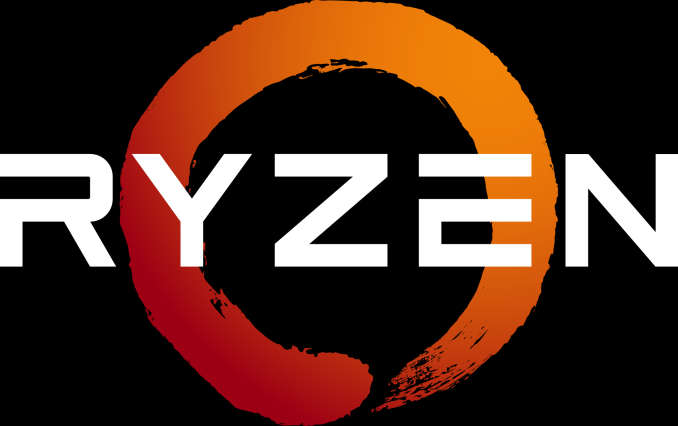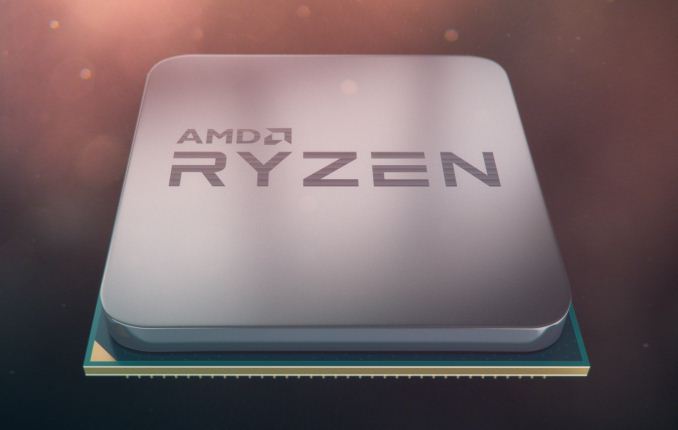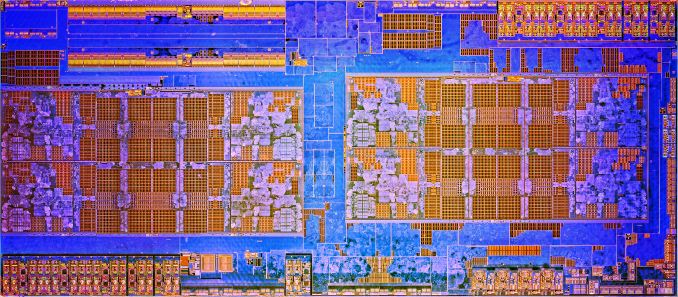AMD Launches Ryzen: 52% More IPC, Eight Cores for Under $330, Pre-order Today, On Sale March 2nd
by Ian Cutress on February 22, 2017 9:00 AM EST
The biggest x86 launch for AMD in five years is today: Ryzen is here. As always before a major launch, AMD gives a ‘Tech Day’ for relevant press and analysts, and through this event AMD’s CEO, Dr. Lisa Su lifted the lid on one of the most anticipated products in the semiconductor industry. AMD knows how to control the level of enthusiasm for its fans, and today is the end result, with processors going on pre-order from major retailers today at 1pm EST, ready for a general hard launch on March 2nd.
In a similar vein to launches of recent smartphones, AMD is doing a staggered announcement/launch with the products on their new microarchitecture. Where Samsung/Apple might give all the details for a product a few weeks before it’s available to buy, today on February 22nd marks the day where AMD is giving consumers information about Ryzen, and specifically the Ryzen 7 family of eight-core products. All the information today is from AMD, and AMD’s internal testing, and pre-orders also start from today for users ready to put down their money for a launch day part. Reviews of the CPUs, as well as when the CPUs will ship to customers, is on March 2nd. This also happens to be right in the middle of two annual shows, Game Developer Conference (GDC) and Mobile World Congress (MWC), making the time between receiving pre-launch samples and being able to provide independent verification of AMD’s performance claims relatively frantic. We’ll do our best!
The Ryzen Family
With a new processor launch, naming the parts and positioning them within the market is critical. So with Ryzen, the processor stack will be split into three based on performance and price: Ryzen 7 at the high end, Ryzen 5 in the middle, and Ryzen 3 for more price-conscious consumers. Both Ryzen 5 and Ryzen 3 are set to be launched later, and Ryzen 7 is the first portion of the family to be released.
Ryzen 7 will have three CPUs to start, all having eight cores and supporting simultaneous multi-threading:
- Ryzen 7 1800X: 8C/16T, 3.6 GHz base, 4.0 GHz turbo, 95W, $499
- Ryzen 7 1700X: 8C/16T, 3.4 GHz base, 3.8 GHz turbo, 95W, $399
- Ryzen 7 1700: 8C/16T, 3.0 GHz base, 3.7 GHz turbo, $329
Ryzen 7 1800X will be the high-end part, featuring a base clock of 3.6 GHz and a turbo of 4.0 GHz, within a TDP of 95W, and for $499. Next to this is Ryzen 7 1700X, launching at $399, with a base/turbo of 3.4/3.8 GHz. The final part for the launch is the Ryzen 7 1700, providing eight cores and sixteen threads for $329 at 3.0/3.7 GHz frequencies.
Processors will initially be available for pre-order from 185 retailers and OEMs worldwide, either as individual parts or pre-built systems.
What, not 40% IPC? 52% IPC??
Enthusiasts and analysts use the term IPC, or ‘Instructions Per Clock’, as a measure of how much the underlying microarchitecture improves from generation to generation. Two decades ago, a good design on a smaller node could net a healthy double-digit gain, whereas in recent years 5-10% gain has become the norm. When AMD initially announced that the new Zen microarchitecture they were developing was aiming for a 40% IPC gain, despite the low IPC they were starting from, users remained skeptical. AMD rehired Jim Keller to work alongside long-term AMD architect Mike Clark and produce a team with several goals in mind: high-performance x86, simultaneous multithreading, and a product to be relevant in the computing, PC, server and mobile space again. So despite this, 40% IPC always seemed a somewhat lofty goal, because Bulldozer was so underwhelming, and despite this low starting point. For the Ryzen launch today, AMD is stating that the final result of that goal is a 52% gain in IPC.
This is something we will need to test in due course!
The Ryzen Silicon, and the Future
AMD pointed out that the new 8-core silicon design runs 4.8 billion transistors and features 200m of wiring. Through previous announcements we’ve examined parts of the microarchitecture including cache sizes, threading, front-end/back-end design, and so on.
AMD Zen Microarchiture Part 2: Extracting Instruction-Level Parallelism
AMD Gives More Zen Details: Ryzen, 3.4 GHz+, NVMe, Neural Net Prediction, & 25 MHz Boost Steps
AMD’s CEO was keen to point out that this is a from-scratch design for AMD, using the knowledge gained from features developed for previous products but ultimately under the hood it looks like ‘a typical x86 high-performance core’, with AMD-specific features and tweaks. We were told that AMD’s roadmap extends into the multi-year range, so while the focus for 2017 will be on this family of products, back at HQ the next two generations are in various stages of development.
BENCHMARKS PLEASE
So despite the 82+ motherboards going to be available, 19 initial PC system builders moving into 200+ through the first half of 2017, the big question on everyone’s lips is how exactly does it perform?
Well, AMD gave us the following numbers:
AMD's benchmarks showed that the top Ryzen 7 1800X, compared to the 8-core Intel Core i7-6900K, both at out-of-the-box frequencies, gives an identical score on the single threaded test and a +9% in the multi-threaded test. AMD put this down to the way their multi-threading works over the Intel design. Also, the fact that the 1800X is half of the price of the i7-6900K.
In a similar vein, again with the Cinebench 15 multi-threaded test, the Ryzen 7 1700X scores over and above the Core i7-6800K (its price competition) and higher than the Core i7-6900K which costs 2.5 times as much.
We’ll tell you what our benchmarks say, with official retail processors. But you will have to wait until March 2nd. Sorry.





















386 Comments
View All Comments
Bleakwise - Thursday, February 23, 2017 - link
Intel is running server Broadwell-E xeons at 4w per core, which is the same or lower than what Arm can do, when you add IPC per core to the mix, or SMT/HT, Intel and x86 is destroying ARM, literally just destroying ARM not only matching them at power usage (4w per core) but having 2-5x the computing potential, more if you count SSE and AVX units.Bleakwise - Thursday, February 23, 2017 - link
I mean do we really think dual core ARM chips that get out-performed by chips from 20 years ago such as the Athlon 64 are going to define the future? Gee I wonder how much power an Athlon x2 would use on a modern node? ARM is nothing special.Bleakwise - Thursday, February 23, 2017 - link
To be clear, > 64 core/128 thread systems and HUGE memory busses are going to be the way forward into the future as we move from the Information Age of information storage to the AI Age of Turing Passing (not the lambda test, but the "can trick your average low/modest IQ human" test) information processing, and wattage per core is going to be the determining metric.Bleakwise - Thursday, February 23, 2017 - link
Along with IPC per core and MT performance of course.Meteor2 - Thursday, February 23, 2017 - link
I think that useage is going to be delivered more by GPUs and FGPAs more than conventional CPUs.Bleakwise - Thursday, February 23, 2017 - link
Lets not forget AMD is using Samsung for their fab. Ryzen is really an AMD/Samsung joint venture, it's Samsung's process that made it possible.One has to wonder when TSMC will be ready. Cannonlake is coming in Q2 and it will bring with it the first 6 core Desktop i7, complete with a pretty decent GPU borrowing from Radeon technology and 15% IPC gains. 6 core Intels usually retail around 400-500$, lets say the 15% IPC boost lets the 6 core Cannonlake beat the 8 core 6900k and 1700x, and rub on the 1800x with less cores and beterr IPC.
Lets say it retails for 429$ the price of the current 6 core. Remember it's going to have an HSA-like OpenCL 2.0 accelreator, what if there is some killer game /app that uses that for some kind of feature? Who is going to be cutting prices then?
Zrat - Thursday, February 23, 2017 - link
Intel said that Cannonlake would be 15% faster than Kaby Lake, not having 15% more IPC.It's the same statement they used for Kaby Lake compared to Skylake: 15% faster. In reality all the performance gains were coming from frequency bump.
If Cannonlake has not a really enhanced architecture, the only resort for Intel is to push frequencies.
Meteor2 - Thursday, February 23, 2017 - link
No. The 6C i7 chips will be Coffee Lake parts, coming late this year. They'll be 14 nm parts and will likely have no IPC gain over Skylake, just as Kaby Lake doesn't. Just maybe slightly higher clock speeds for the same power.Cannon Lake is the 10 nm consumer parts. They will likely launch as Core M parts first, but not in 2017, and not before some unknown kind of datacentre chips using 10 nm have been released. There is no release date, rumoured or otherwise.
It's also not totally clear Intel cores do more work with 4/5W of power than anyone else's. Apple's AnX chips might be better, but as they only run iOS and are only in iPads, they can't be meaningfully compared.
cheshirster - Thursday, February 23, 2017 - link
6 core i7 is not coming to dual channel motherboards.Outlander_04 - Thursday, February 23, 2017 - link
The Ryzen processors are built by Global Foundaries , not Samsung .If Samsung were building them they would be taping out gen 2 in 10 nm right now